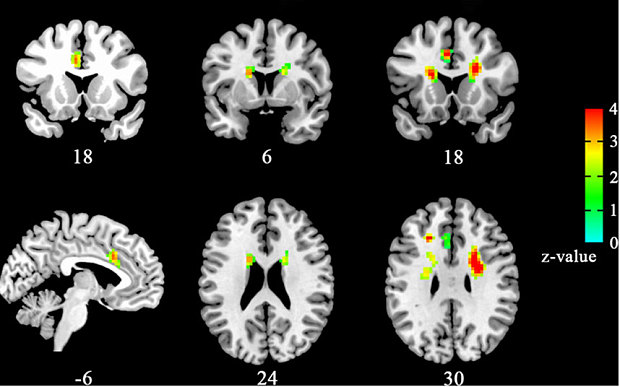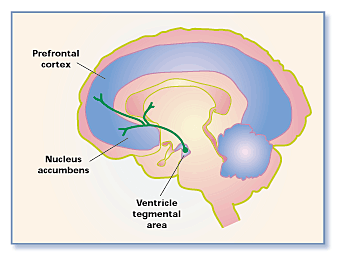This is an old revision of the document!
Table of Contents
Love & Hate
Love is comprised of various positive and strongly experience emotional and mental states. Driving love are three components: lust, attachment, and attraction. Each component of love is influenced by various hormones and neurotransmitters that affect our brain's reward circuit. Two regions that become active when in love include the caudate nucleus and the ventral tegmental area, also known as the reward circuit. This circuit is linked with the nucleus accumbens, with the function of operating dopamine and serotonin. Other structures that contribute to the reward circuit include the amygdala, the hippocampus, and the prefrontal cortex. In contrast, heartbreaks result from traumatic breakups or the death of a loved one. In extreme events the emotional distress can be so severe it can result in the alteration of the left ventricle. As a consequence, many symptoms arise and are known to be associated with the heartbreak syndrome or as Takotsubo Cardiomyopathy (TC). Neurochemical processes such a them-opioid receptor and drastic declines in love neurotransmitters such as dopamine and oxytocin have been shown to cause the brain to react negatively and seek out social contact. Beyond heartbreak, hate is also a common emotion that is felt. Hate, in its simplest form, is to have a strong emotional response to extreme dislike. One can manifest a hatred for a variety of things, including an individuals and groups of people. A study based on “the hate circuit” has proposed that the reason why we hate is due to the same four areas of the brain being activated, which is consistent across all individuals and which help with motor and decision planning when confronted with a hated person. Potential treatments include painkiller, opioids, placebo, social support and even comfort food to demission activation of areas of the brain that cause both physical pain and emotional social separation stress.
What is Love
Love pertains to multiple strong and positively experienced mental and emotional states, ranging from deep affection to simple pleasures (Love, 2018).
So why do we fall in love? It is thought that the romance part of love is one of three basic brains systems that evolved for mating and production. There are three components to love: sex drive or lust, romantic love or attraction, and finally attachment (Fisher H, 2018).
Sex drive or lust: the desire for sexual gratification, allows an individual to seek a range of potential mating partners. It is important to note, you do not have to be in love to experience lust (Fisher H, 2018).
Romantic love, or attraction: often described as obsessive thinking or craving for a specific individual. It has been suggested that this process evolved to allow individuals to focus their mating energy on one person (Fisher H, 2018).
Attachment: a feeling of deep union and connection with an individual, evolved to ensure that you remain with your mate long enough to ensure the survival of your offspring (Fisher H, 2018).
Biology of Love
It is known that lust is driven by sexual gratification. This need to be fulfilled sexually is driven by the hypothalamus, which signals to the ovaries and testes to release the hormones estrogen & testosterone (Wu, 2018). Both hormones impact the male & female sexually, where testosterone is thought to increase one’s sexual libido (Wu, 2018). Contrast to this is estrogen which is thought to have a lesser effect than testosterone. Despite this, some females have indicated feeling the most sexually motivated around ovulation when estrogen levels are highest.
Typically, one lusts for one they are attracted to and vice versa. However, it is possible to experience one and not the other. When you're attracted to someone the brain pathways that influence reward behaviour become activated. The activation of this pathway can explain why the first few months of being with someone can feel almost euphoric. The activation of this pathway affects the release of norepinephrine, dopamine & serotonin (Wu, 2018). Dopamine is released from the hypothalamus when we do things that make us feel good in this case spending time or engaging in intercourse with are mate. As dopamine levels peak, norepinephrine is released which is responsible for our high energy and euphoria during attraction, it can also cause loss of appetite and sleep. As these neurotransmitters increase, serotonin begins to decrease. It has been speculated that this decrease in serotonin is related to the overpowering infatuation that occurs with the beginning of love (Wu, 2018).
Attachment is what mediates long term relationships, whether this is romantic, friendship or family related. The hormones responsible for attachment are oxytocin & vasopressin. Similar to dopamine, oxytocin is produced by the hypothalamus (Wu, 2018). Large amounts of oxytocin are then released during sex helping to form feelings of bonds and romantic attachments (Wu, 2018). While it is not completely understood, it thought that increased levels of vasopressin are what allows for monogamy to occur. In a study done on moles that are typically promiscuous, the addition of the vasopressin receptor leads to them being pursuing only one female (Wu, 2018).
It has been suggested, that being in love acts in a feedback loop manner where the brains reward system is activated. The feedback loop is affected by the central nervous system and levels of neurotransmitters found in the blood (Fisher M, 2018). The activated system causes neurotransmitters to be released to various parts of the body like the skin, genitals and stomach, when stimulated they send messages back to the brain. For example, if stimulation of the genitals feels good, this information is sent back to the brain where the system is activated and the individuals seek out more stimulation (Fisher M, 2018).
Your Brain on Love
There have been studies demonstrating functional MRI (fMRI) images of the brain of individuals when they were shown photos of people they romantically loved. As a result, the brain became active in regions rich with dopamine which is known as the “feel-good neurotransmitter” (Fisher 2005). Specifically, two regions became active including the caudate nucleus, associated with reward detection and integration of sensory experiences into social behavior, and the ventral tegmental area, also known as the reward circuit is associated with pleasure and focused attention and motivation to acquire rewards (Fisher 2005). Rewards are defined as the biological mechanisms that motivate behavior by events associated with pleasure.
This reward circuit is considered to be a primitive neural network, therefore is evolutionarily old (Fisher 2005). It is linked with the nucleus accumbens, with the function of operating dopamine (promoting desire) and serotonin (satiety and inhibition). Other structures that contribute to the reward circuit include the amygdala, the hippocampus, and the prefrontal cortex (Fisher 2005). These are very sensitive to behavior associated with pleasure, such as sex, food consumption, and drug use. Chemicals associated with the reward circuit flood our brain, producing a variety of physical and emotional responses when we are falling in love. The responses include a racing heartbeat, sweaty palms, flushed cheeks, feelings of passion and anxiety (Fisher 2005). In addition to this, levels of the stress hormone cortisol increase during the initial phase of romantic love. As cortisol levels rise, levels of the neurotransmitter serotonin become depleted (Fisher 2005). Finally, adrenaline and norepinephrine are responsible for the increased beating of the heart, restlessness and overall preoccupation that go along with experiencing love (LUHS, 2014).
Dopamine activates the reward circuit, making love a pleasurable experience similar to the euphoria, associated with drugs and alcohol (Fisher 2005). A Study from the University of California, demonstrated that male fruit flies that were sexually rejected drank four times as much alcohol as fruit flies that mated with female fruit flies (Fisher 2005). Other chemicals shown during romantic love are oxytocin and vasopressin, that are hormones that play a role in pregnancy, nursing, and mother-infant attachment (Carter, 2012). Oxytocin is released during sex and is enhanced during skin to skin contact. It is the deepened feelings of attachment and makes couples feel closer to one another after having sex (Carter, 2012).This hormone is known as the love hormone that promotes feelings of contentment, calmness, and security, often associated with mate bonding (Carter, 2012). Vasopressin is linked with behaviours that produce long-term relationships. The differences in behaviour associated with the two hormones explains why passionate love fades as attachment grows (Carter, 2012).


